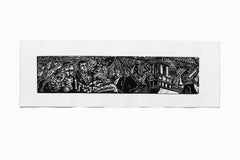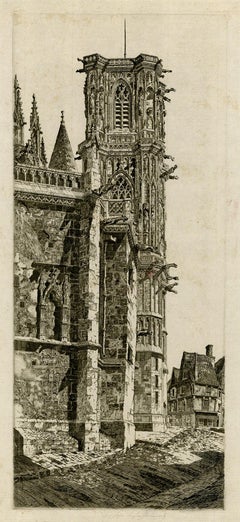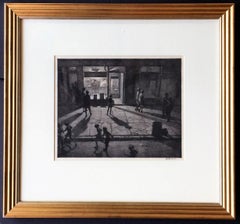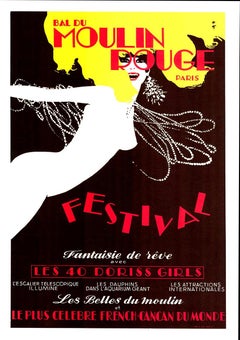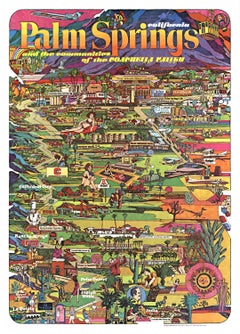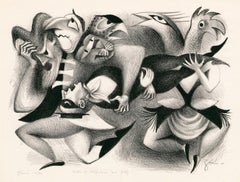American Modern Figurative Prints
to
180
397
136
127
101
58
Overall Width
to
Overall Height
to
15,616
8,173
2,646
2,428
2,254
1,052
1,014
732
671
421
322
112
93
39
74
15
14
14
9
9
785
28
3
18
46
111
97
68
75
77
49
28
515
279
20
483
231
183
182
126
117
109
90
83
73
69
59
55
43
42
36
34
32
28
27
296
203
140
98
78
98
33
789
31
Style: American Modern
"History of Detroit" Linoleum Cut, Black Ink, African American, Mural Style
Located in Detroit, MI
"History of Detroit" is in the style of a mural by the master muralist from the city of Detroit, Hubert Massey. It renders in dramatic composition the ov...
Category
Early 2000s American Modern Figurative Prints
Materials
Linocut
Cathedral of Saint Cyr and Saint Julitta, Nevers
Located in Middletown, NY
Etching on antique cream laid paper, 12 7/8 x 5 1/2 inches (328 x 140 mm), full margins. Signed in pencil, lower margin. Laid down to non-archival board, general age tone and some ma...
Category
Mid-20th Century American Modern Figurative Prints
Materials
Handmade Paper, Laid Paper, Etching
Spring Night, Greenwich Village
By Martin Lewis
Located in Storrs, CT
Spring Night, Greenwich Village. 1930. Drypoint and sand ground. McCarron 85. 10 x 12 3/8 (sheet 13 1/4 x 15 5/8)). Edition 92. A rich, tonal impress...
Category
1930s American Modern Figurative Prints
Materials
Drypoint, Etching
$24,000 Sale Price
20% Off
Original Bal du Moulin Rouge "Festival" French cabaret poster, linen-backed
By René Gruau
Located in Spokane, WA
Original Bal du Moulin Rouge “Festival” Vintage Cabaret Poster. Linen-backed in excellent condition, ready to frame.
Turn your wall into a Paris night. René Gruau’s electric silh...
Category
1980s American Modern Figurative Prints
Materials
Offset
Original Palm Springs and The Communities of The Coachella Valley vintage poster
Located in Spokane, WA
Original Palm Springs, California, and the communities of the Coachella Valley vintage poster. A fun image map of the Palm Springs area and activities and hotspots to visit.
Linen ...
Category
Late 20th Century American Modern Figurative Prints
Materials
Offset
'Victim of Misfortune and Folly' — Surrealist Fantasy
Located in Myrtle Beach, SC
Zena Kavin, 'Victim of Misfortune and Folly, lithograph, c. 1935, edition 20. Signed, titled, and numbered '17/20' in pencil. A fine, richly-inked impression, on cream wove paper, wi...
Category
1930s American Modern Figurative Prints
Materials
Lithograph
Cappiello's Contratto Canelli Vermouth - later printing
Located in Spokane, WA
Original Contratto Canelli Vermouth vintage Italian liquor poster. Archival linen backed and ready to frame. Very good condition. This is the later c.1950 lithograph printing of the poster. Beautiful advertising vintage affiche printed in offset lithography (second edition). There is no second printing date besides the original date inside the poster by Cappiello's signature.
(Note that the earlier printing sells for about $9500.)
Most standard size original Italian posters are 39" x 55" in size; or 27.5" x 39 half sheets.
This is currently the lowest and best price for this Cappiello Contratto poster on 1st Dibs.
The woman in this Cappiello poster rests on a large green maple leaf while holding a bottle of Vermouth Victor and a bottle of Vermouth Bianco...
Category
Late 20th Century American Modern Figurative Prints
Materials
Offset
Building a Babylon, Tudor City, NY.
By Martin Lewis
Located in Storrs, CT
McCarron 76. 12 7/8 x 7 7/8 (sheet 16 5/8 x 12 1/4). 6th trial proof (McCarron records 84 impressions including 4 trial proofs). Illustrated L'Amérique de la Dépression: Artistes En...
Category
Early 20th Century American Modern Figurative Prints
Materials
Drypoint, Etching
$11,000 Sale Price
26% Off
Fifth Avenue Bridge.
By Martin Lewis
Located in Storrs, CT
Fifth Avenue Bridge. 1928. Drypoint. McCarron 72. 9 7/8 x 12 (sheet 12 3/4 x 15). Edition of 108 recorded impressions. A rich impression printed on cream laid paper, with full margin...
Category
1920s American Modern Figurative Prints
Materials
Drypoint, Etching
Original "Wonderful Copenhagen" vintage travel poster
Located in Spokane, WA
Original vintage poster: WONDERFUL COPENHAGEN created by the artist Viggo Vagnby. This antique poster is archival linen-backed, in excellent condition, and ready to frame. No da...
Category
1950s American Modern Figurative Prints
Materials
Lithograph
Original California Ferrari Louis Vuitton Parc de Bagatelle hand signed poster
Located in Spokane, WA
Original 1989 Louis Vuitton Automobile Classiques Poster –Hand Signed, Archival Linen-Backed. This poster was created for the Concours d’Elegance ...
Category
1980s American Modern Figurative Prints
Materials
Lithograph
Manhattan Mountains
Located in Storrs, CT
Manhattan Mountains. 1938. Etching and drypoint. 14 3/4 x 12 3/8 (sheet 17 1/4 x 14 3/4). Artist proof, previous to the edition of 40. An atmospheric impression printed on buff-colored laid paper. Signed and dated in the plate. Signed, titled, and annotated 'Final state' and 'Jones Proof'in pencil. Housed in an archival sleeve.
Painter and printmaker Lawrence Nelson...
Category
20th Century American Modern Figurative Prints
Materials
Drypoint, Etching
Original 1933 Concours de Photographie e Cinematographie vintage French poster
Located in Spokane, WA
Original 1933 French Poster — Touring Club de France “Concours de Photographie et de Cinématographie” — Art Deco — Linen Backed Vintage Advertising Grade a- condition with minor r...
Category
1930s American Modern Figurative Prints
Materials
Lithograph
A Handsome 1930s Rockwell Kent Lithograph on Paper, Titled "Canterbury Tales"
Located in Chicago, IL
A handsome 1930s Rockwell Kent lithograph on paper, titled "Canterbury Tales". Nicely matted and framed in a gold-toned frame. Image size: ...
Category
1930s American Modern Figurative Prints
Materials
Paper, Lithograph
'Unemployed Marchers' — American Modernism, WPA
By Leon Bibel
Located in Myrtle Beach, SC
Leon Bibel, 'Unemployed Marchers', 2-color lithograph, c. 1938, edition 25. Signed, titled, and numbered '2/25' in pencil. A fine, richly-inked impression on off-white, wove paper, w...
Category
1930s American Modern Figurative Prints
Materials
Lithograph
Simka Simkhovitch WPA Artist Lithograph Island Beach 1933 American Modernist
Located in Surfside, FL
Simka Simkhovitch (Russian/American 1893 - 1949) signed lithograph. Pencil signed and dated "S. Simkhovitch 1933" lower center. Title "Island Beach,"...
Category
1930s American Modern Figurative Prints
Materials
Lithograph
'Tenant Farmers' — Depression Era, WPA
By Lou Barlow
Located in Myrtle Beach, SC
Lou Barlow (Louis Breslow), 'Tenant Farmers', color wood engraving, 1936, edition 25. Signed, titled, and numbered '15/25' in pencil. A superb, richly-inked impression, with fresh c...
Category
1930s American Modern Figurative Prints
Materials
Woodcut
Madman's Drum (Brothel) — 'Story Without Words' Graphic Modernism
By Lynd Ward
Located in Myrtle Beach, SC
Lynd Ward, 'Madman's Drum, Plate 41', wood engraving, 1930, edition small. Signed in pencil. A fine, richly-inked impression, on off-white tissue-thin Japan paper; the full sheet with margins (1 5/8 to 2 1/2 inches); a small paper blemish in the upper right margin, away from the image, otherwise in excellent condition. A scarce, artist-printed, hand-signed proof impression before the published edition. Matted to museum standards, unframed.
Image size 5 1/2 x 3 3/4 inches (140 x 95 mm); sheet size 9 5/8 x 7 1/8 inches (244 x 181 mm).
From Lynd Ward’s book of illustrations without words, 'Madman’s Drum', Jonathan Cape and Harrison Smith, New York, 1930.
Reproduced in 'Storyteller Without Words, the Wood Engravings of Lynd Ward', Harry N. Abrams, New York, 1974.
ABOUT THE ARTIST
Lynd Ward is acknowledged as one of America’s foremost wood engravers and book illustrators of the first half of the twentieth century. His innovative use of narrative printmaking as a stand-alone storytelling vehicle was uniquely successful in reaching a broad audience. The powerful psychological intensity of his work, celebrated for its dynamic design, technical precision, and compelling dramatic content, finds resonance in the literature of Poe, Melville, and Hawthorne. Like these classic American writers, Ward was concerned with the themes of man’s inner struggles and the role of the subconscious in determining his destiny. An artist of social conscience during the Great Depression and World War II, he infused his graphic images with his unique brand of social realism, deftly portraying the problems that challenged the ideals of American society.
The son of a Methodist preacher, Lynd Ward, moved from Chicago to Massachusetts at an early age. He graduated from the Teachers College of Columbia University, New York, in 1926, where he studied illustration and graphic arts. He married May Yonge McNeer in 1936 and left for Europe for their honeymoon in Eastern Europe. After four months, they settled in Leipzig, where Ward studied at the National Academy of Graphic Arts and Bookmaking. Inspired by Belgian expressionist artist Frans Masereel's graphic novel ‘The Sun,’ and another graphic novel by the German artist Otto Nückel, ‘Destiny,’ he determined to create his own "wordless" novel. Upon his return to America, Ward completed his first book, ‘God's Man: A Novel in Woodcuts,’ published in 1929. ‘Gods’ Man’ was a great success for its author and publisher and was reprinted four times in 1930, including a British edition. This book and several which followed it, ‘Madman’s Drum,’ 1930, ‘Wild Pilgrimage...
Category
1930s American Modern Figurative Prints
Materials
Woodcut
Original 1974 "Madhouse" vintage 1-sheet movie poster. NSS 74/9
Located in Spokane, WA
Original Madhouse vintage 1974 movie poster, folded as issued.
Very good condition with bright colors. No pin holes. Very minor edge wear Very good condition, ready to frame. See images.
We flatten the poster at the time it is scanned to provide you with the most detailed and correct color of the vintage poster...
Category
1970s American Modern Figurative Prints
Materials
Offset
$159 Sale Price
20% Off
Seventh Avenue Canyon, from New York in Etchings
By Anton Schutz
Located in Middletown, NY
New York: 1939.
Etching on light weight wove paper, 13 3/4 x 10 3/4 inches ( 350 x 273 mm); 15 1/4 x 12 inches; sheet (383 x 300 mm); full margins. Signed in pencil in the lower mar...
Category
Early 20th Century American Modern Figurative Prints
Materials
Etching
THE RUG WEAVER
Located in Santa Monica, CA
GUSTAVE BAUMANN (1881 – 1971)
THE RUG WEAVER, 1910 (Chamberlain 26)
Color woodcut signed in pencil. Unnumbed from an edition 100 as published in the Hills o’ Brown...
Category
1910s American Modern Figurative Prints
Materials
Woodcut
'Cargo Carriers' — New York Harbor
By Otto Kuhler
Located in Myrtle Beach, SC
Otto Kuhler, 'Cargo Carriers', etching and drypoint, c. 1932, edition 10, Kennedy 44. Signed in pencil. A superb, atmospheric impression with rich burr and selectively wiped overall plate tone, in dark brown ink, on Arches cream laid paper; wide margins (2 to 2 3/4 inches), in very good condition. Printed by the artist. Original Kennedy Galleries mat and label. Very scarce.
"On my trips up and down N.Y. harbor on the Weehawken Ferry, the late evening sun playing on the side of the big liners has always intrigued me... The liner shown I believe to be the Vaterland of the North German Lloyd...
Category
1930s American Modern Figurative Prints
Materials
Etching, Drypoint
$1,440 Sale Price
20% Off
II Cup of Joe
Located in San Francisco, CA
This artwork titled "II Cup of Joe" c.1990, is an original color serigraph by American artist Rickey Jewell Hohimer, 1946-2021. It is hand signed, titled and numbered 250/300 in pencil by the artist. The image size is 19.5 x 23.5 inches, framed size is 26.75 x 30 inches. The artwork is in excellent condition, the frame is slightly damaged at the top, and will be replaced by a new similar black frame when sold. This will bring the over all condition to excellent.
About the artist:
Although formally trained with a MFA in painting, Rickey Jewell Hohimer has used the styles of Van Gogh and Gaughin to reach for the spontaneity and simplicity of today's folk art. Hohimer creates figures which are not photos of reality; they are romantically stylized to encourage straightforward emotional responses both to the colorful images and to the situations in which they find themselves. Each of Hohimer's paintings lays out a basic story line to which viewers add their own details. "I want the viewer to become personally involved. My paintings offer a change from those which encourage extensive intellectualizing about what the artist is trying to convey. I want viewers to smile -- to enjoy the whimsical nature of what they are experiencing -- to feel it, not to analyze it!. His jazz paintings are stories on canvas of inspired musicians spontaneously making music of the moment. Life in the jazz age is clubs and nightlife beckoning to musicians to produce jazz art...
Category
Late 20th Century American Modern Figurative Prints
Materials
Screen
The Print Shop
Located in Santa Monica, CA
GUSTAVE BAUMANN (1881 – 1971)
THE PRINT SHOP 1910 (Chamberlain 27)
Color woodcut signed in pencil. Unnumbed from an edition 100 as published in the
Hills o’ Brown Portfolio, (plate 11 of 12). Image 9 x 13 1/8, sheet 10 ¼ x 13 7/8 with
deckle edge at the bottom. The print portrays the Brown County...
Category
1910s American Modern Figurative Prints
Materials
Lithograph
Jazz : Swing Guy (Yellow) - Screenprint Poster, Montreux, 1983
By Keith Haring
Located in Paris, IDF
Keith Haring
Swing Guy (Yellow), 1983
Screenprint
Printed signature in the plate
On heavy paper 100 x 70 cm (c. 40 x 28 in)
Created by Haring for the Montreux Jazz Festival
Excelle...
Category
1980s American Modern Figurative Prints
Materials
Screen
'Soaring New York' — 1930s American Modernism, New York City
Located in Myrtle Beach, SC
Howard Cook, 'Soaring New York', aquatint, soft-ground etching, roulette, 1931-32, edition 25, Duffy 165. Signed, dated, and annotated 'imp' in pencil. A superb, richly-inked, atmosp...
Category
1930s American Modern Figurative Prints
Materials
Etching, Aquatint
Shadows on the Ramp
By Martin Lewis
Located in Storrs, CT
Shadows on the Ramp. 1927. Drypoint and sand ground. McCarron 64. 9 x 10 1/2 (sheet 12 3/8 x 14). Edition 75 recorded impressions. A rich, tonal impression with drypoint burr, printe...
Category
1920s American Modern Figurative Prints
Materials
Drypoint, Etching
'Judgment of Souls' — Surrealist Fantasy
Located in Myrtle Beach, SC
Zena Kavin, 'Judgment of Souls', lithograph, c. 1935, edition 20. Signed, titled, and numbered '17/20' in pencil. A fine, richly-inked impression, on cream wove paper, with full marg...
Category
1930s American Modern Figurative Prints
Materials
Lithograph
Original Hawaii United Airlines vintage Hawaiiana travel poster 1967
Located in Spokane, WA
ORIGINAL 1967 United Air Lines HAWAII Travel Poster by James Jebary - Mid-Century Modern Wall Art, 25"x40"
This isn't a reprint! You're viewing a...
Category
1960s American Modern Figurative Prints
Materials
Offset
Profile of an African Woman — 1920s Modernism
Located in Myrtle Beach, SC
Boris Lovet-Lorski, Untitled (Profile of an African Woman), lithograph, edition 250, 1929. Signed and numbered 15 in pencil. Number 15 of Volume 2, a series of 10 lithographs publish...
Category
1920s American Modern Figurative Prints
Materials
Lithograph
Original Pin-Up - Telephone Call linen backed vintage pinup girl.
Located in Spokane, WA
Behold the original lithographic Petty Pin-up, a unique vertical-format piece. The see-through bathing suit she wears seems to make her glow, especially with her red hair peeking fro...
Category
1940s American Modern Figurative Prints
Materials
Lithograph
On the Beach (Coney Island, New York) — 1930s Graphic Modernism, WPA
By Lou Barlow
Located in Myrtle Beach, SC
Lou Barlow (Louis Breslow), 'On the Beach' (Coney Island) wood engraving, c. 1937, edition c. 25. Signed and titled in pencil. Stamped 'FEDERAL ART PROJECT NYC WPA' in the bottom left margin. A fine, richly-inked impression, with all the fine lines printing clearly, on cream wove paper, with full margins (1 1/2 to 3 inches), in excellent condition. Matted to museum standards, unframed. Scarce.
Image size 11 x 8 1/8 inches; sheet size 16 x 11 3/8 inches.
Created during the Great Depression for the Works Progress Administration (WPA), Federal Art Project, New York City.
Impressions of this work are in the permanent collections of the Amon Carter Museum of Art, Illinois State Museum, and the New York Public Library.
ABOUT THE IMAGE
Due to Coney Island's proximity to Manhattan, Brooklyn, and other New York boroughs, it began attracting vacationers in the 1830s and 1840s. Most of the vacationers were wealthy and went by carriage roads and steamship services that reduced travel time from a formerly half-day journey to two hours. By the late 1870s, the development of Coney Island's amusement park attractions and hotels drew people from all social classes. When the Brooklyn Rapid Transit Company electrified the steam railroads and connected Brooklyn to Manhattan via the Brooklyn Bridge at the beginning of the 20th century, Coney Island turned rapidly from a resort to an accessible location for day-trippers seeking to escape the summer heat in New York City's tenements. In 1915, the Sea Beach Line was upgraded to a subway line, and the opening of the Stillwell Avenue station in 1919 ushered in Coney Island's busiest era. On the peak summer days, over a million people would travel to Coney Island. In 1937, New York City purchased a 400-foot-wide strip of land along the shoreline to allow the boardwalk to be moved 300 feet inland. At this point, Coney Island was so crowded on summer weekends that parks commissioner Robert Moses...
Category
1930s American Modern Figurative Prints
Materials
Woodcut
Low Country (South Carolina)
Located in Middletown, NY
An enchanting Southern landscape by the mother of the Charleston Renaissance.
A native of Charleston, South Carolina, and educated under the tutelage of Thomas Anshutz at The Pennsylvania Academy of Fine Arts, O'Neill Verner was a teacher, a mother, an artist, an ardent preservationist, and a skilled autodidact. Having previously focused on painting, in the early 1920s she found herself deeply moved by printmaking as a media, and especially so by the simple, peaceful themes and tableaus she discovered in Japanese art. She embarked on a effort to teach herself Japanese printmaking techniques, and in the process, produced the charming images of every day life in Charleston and its environs that earned her recognition as a cultural icon in her day, and in more modern times, as the mother of the Charleston Renaissance, which flourished well into the 1930s. In 1923 she opened a studio in Charleston where she focused on documenting the local color and the architecture and landscape that distinguishes Charleston as one of the South's most beautiful cities, all the while applying the gentle and poetic thematic sensibilities of Japanese printmaking. O'Neill Verner soon found herself in high demand when municipalities and institutions throughout the country sought commissions from her to document the beauty of their grounds and historic buildings. She worked as far north as the campuses of Harvard and Princeton, and extensively across the South, including in Savannah, Georgia, where through sweeping commissions she was able to marry her love of southern preservation and art. O'Neill Verner was a lifelong learner, and continued a path of edification that led her to study etching at the Central School of Art in London, to travel extensively through Europe, and to visit Japan in 1937, where she studied sumi (brush and ink) painting. She was a founding member of the Charleston Etchers Club, and the Southern States Art League. Her works are represented in the permanent collections of leading museums across the American south, and in major national institutions including the Metropolitan Museum of Art, Boston's Museum of Fine Art, and the Smithsonian American Art Museum. O'Neil Verner...
Category
Early 20th Century American Modern Figurative Prints
Materials
Archival Paper, Drypoint, Etching
Ben Shahn Original Hand Signed Litho WPA Artist Rilke Poem Lithograph Portfolio
By Ben Shahn
Located in Surfside, FL
"To Days of Childhood That are Still Unexplained". It depicts six female silhouette figures in long dresses or coats against a blue and pastel purple background. From the Rainier Ma...
Category
1950s American Modern Figurative Prints
Materials
Lithograph
The Gothic Spirit
Located in Storrs, CT
The Gothic Spirit (also called A Gargoyle, A Gothic Spirit). 1922. Etching and stipple. Fletcher 120. 11 5/8 x 7 (sheet 15 1/4 x 11 1/4). Gargoyle Series #8. Edition 130. Illustrated...
Category
1920s American Modern Figurative Prints
Materials
Drypoint, Etching
$2,500 Sale Price
28% Off
'Havoc in Heaven' — Mid-Century Modernism
Located in Myrtle Beach, SC
Benton Spruance, 'Havoc in Heaven', lithograph, 1948, edition 30-35, Fine and Looney 270. Signed, titled, and numbered 'Ed 35' in pencil. Initialed in the stone, lower right. A fine,...
Category
1940s American Modern Figurative Prints
Materials
Lithograph
Stoops in Snow
By Martin Lewis
Located in Storrs, CT
Stoops in Snow. 1930. Drypoint and sandpaper ground. McCarron catalog 89.state ii. 9 x 14 7/8 (sheet 13 1/4 x 18 7/16 ). Edition 115 recorded impressio...
Category
1930s American Modern Figurative Prints
Materials
Drypoint, Etching
$35,000 Sale Price
30% Off
'Wild Pilgrimage' (Contemplation) — 'Story Without Words' Graphic Modernism
By Lynd Ward
Located in Myrtle Beach, SC
Lynd Ward, 'Wild Pilgrimage', No. 26, wood engraving, 1932, edition not stated but very small. Signed in pencil. A fine, black impression, with full margins (1 1/16 to 3 3/16 inches), on tissue-thin cream Japan paper, in very good condition. A scarce, artist-printed, hand-signed proof impression before the published edition. Matted to museum standards, unframed.
Created by Lynd Ward for his narrative book of illustrations without words, 'Wild Pilgrimage', published by Harrison Smith...
Category
1930s American Modern Figurative Prints
Materials
Woodcut
Fourteenth Street. The Wigwam. (Tammany Hall).
By John Sloan
Located in Storrs, CT
1928. Etching. Morse catalog 235. state ii. Image: 9 3/4 x 7 (sheet 17 1/4 x 11 3/8). From the first printing of 100 proofs by Peter Platt. There were an additional 10 printed by Er...
Category
1920s American Modern Figurative Prints
Materials
Etching
$2,560 Sale Price
36% Off
Ethel Katz, Fur Tailors, New Deal-era lithograph of sweatshop
Located in New York, NY
This is a classic New-Deal image: claustrophobic sweatshop with a row of hunched tailors. The windows and lamps offer light at least. But there is a major difference between this and...
Category
1930s American Modern Figurative Prints
Materials
Lithograph
Original The Rocky Horror Picture Show US 1 sheet movie poster, on linen, 1975
Located in Spokane, WA
Original The Rocky Horror Picture Show vintage movie poster, professionally linen backed with original fold marks restored, The Rocky Horror Picture Show. A different set of jaws. ...
Category
1970s American Modern Figurative Prints
Materials
Offset
Peace
Located in Fairlawn, OH
Peace
Woodcut printed in orange red ink on japanese paper
Signed and titled in pencil lower right (see photo)
Titled lower left (see photo)
Created along with an illustrated book project Song of Peace, 1950-1959.
Condition: Excellent
Image: 10 1/2 x 4 7/8"
Sheet: 16 1/8 x 7";
Anton Refregier (March 20, 1905 – October 10, 1979) was a painter and muralist active in Works Progress Administration Federal Art Project commissions, and in teaching art. He was a Russian immigrant to the United States.
Among his best-known works is his mural series The History of San Francisco, located in the Rincon Center in downtown San Francisco, California. It depicts the city's history across twenty seven panels that he painted from 1940 to 1948.
Life and early career
Refregier was born in Moscow and emigrated to the United States in 1920. After working various odd jobs in New York City, he earned a scholarship to the Rhode Island School of Design in 1921. After finishing school, Refregier moved back to New York in 1925. To earn a living, Refregier worked for interior decorators, creating replicas of François Boucher and Jean-Honoré Fragonard paintings...
Category
1950s American Modern Figurative Prints
Materials
Woodcut
Original Baby in bidet - Manifattura Ceramica Pozzi vintage Italian poster
Located in Spokane, WA
Original poster showing a “Baby in a Bidet”. In Italian it is Maniffatura Ceramica Pozzi. Linen backed in very fine condition, ready to frame. This Italian poster was only know...
Category
1950s American Modern Figurative Prints
Materials
Offset
C'est La Vie (Classic Car, Graveyard, Vintage, ~35% OFF - LIMITED TIME ONLY)
Located in Kansas City, MO
Louise Marler
C'est La Vie (from "Oil is History" Collection) (Classic Car, Graveyard, Vintage)
Archival Giclee Print
2007
Edition: 10
Image Size: 15.25 x 21.25 inches (38.74 × 53.98...
Category
1970s American Modern Figurative Prints
Materials
Metal
Wrexham Tower, Yale University
Located in Middletown, NY
Etching with aquatint on watermarked cream laid J Perrigot Arches paper, 15 7/8 x 9 3/4 inches (400 x 248 mm), full margins. Signed, dated, and dedicated to the the artist Ruth Knobl...
Category
Early 20th Century American Modern Figurative Prints
Materials
Handmade Paper, Etching, Aquatint
'To Market, to Market' — Surrealist Fantasy
Located in Myrtle Beach, SC
Zena Kavin, 'To Market, to Market', lithograph, c. 1935, edition 20. Signed, titled, and numbered '6/20' in pencil. A fine, richly-inked impression, on cream wove paper, with full ma...
Category
1930s American Modern Figurative Prints
Materials
Lithograph
$360 Sale Price
20% Off
Madison Square, N.Y.C.
Located in Middletown, NY
New York: 1947.
Etching on white wove paper, 7 x 5 inches (752 x125 mm), full margins. Signed and titled in pencil, lower margin. In very good condition with some minor spots of ligh...
Category
Mid-20th Century American Modern Figurative Prints
Materials
Etching
Original Mardi Gras New Orleans 1978 festival serigraph poster
Located in Spokane, WA
Original Mardi Gras, New Orleans, 1978 linen-backed poster. Dressed up in what would be an American Indian costume with full headgear, he is holding a shield with a horse on it. Indian decoration on the footwear. Signed and numbered.
I believe this has to deal with Big Chief leading his Congo Nation Mardi Gras Indian group. Zulu Parade. Many of the original Mardi Gras jazz posters...
Category
1970s American Modern Figurative Prints
Materials
Screen
$636 Sale Price
20% Off
Somewhere in France
Located in Middletown, NY
Etching on antique cream laid paper with a partial watermark (likely Arches), 12 1/8 x 6 1/8 inches (308 x 156 mm), full margins. Signed and dated in pencil in the lower right margin...
Category
Mid-20th Century American Modern Figurative Prints
Materials
Handmade Paper, Laid Paper, Etching
The Enchanted Doorway; Venezia
Located in Middletown, NY
Etching and drypoint on antique cream laid paper, 12 3/8 x 6 9/16 inches (315 x 167 mm), full margins. Signed, dated, and inscribed "Edition 100" in pencil, lower margin. In very goo...
Category
Early 20th Century American Modern Figurative Prints
Materials
Handmade Paper, Etching, Drypoint
Original Rome Fly TWA Jets vintage American travel poster
By David Klein
Located in Spokane, WA
Original Rome Fly TWA Jets vintage travel poster. Conservation linen backed in excellent condition, ready to frame. This is the earlier edition of the image Before ‘up up and away’!
TWA (Trans World Airlines) was formed in 1924 as Transcontinental & Western Air. The airline's first route was from New York to Los Angeles, followed by multiple National routes. The airline expanded to serve Europe, the Middle East, and Asia after WWII when the company was under Howard Hughes's owner's control from 1939 until 1961. Hughes was a dominant force in expanding and promoting his company's routes. The economy was vastly improving, and travel by air for business and pleasure increased, too. Posters were a crucial element in promoting this form of travel and TWA. The airline started a decline in the 1970s, ending in a third bankruptcy that caused its acquisition by American Airlines in 2001. The airline operated in 132 destinations worldwide and had a fleet size of 190.
This Rome poster was created by the gifted American artist David Klein (1918 -2005), and depicts a member of the Pontifical Swiss Guard in the center wearing the iconic yellow, blue, and red uniform. The Guard is playing a drum that has the pontifical emblem. In the background, we see a representation of the ancient Roman Coliseum and the Baroque...
Category
1960s American Modern Figurative Prints
Materials
Offset
$628 Sale Price
20% Off
Original "The Rocky Horror Picture Show' US 1 sheet vintage movie poster 1975
Located in Spokane, WA
Original "The Rocky Horror Picture Show" US 1-sheet vintage movie poster. Archvial linen backed. 1975, Style B. Original fold marks pr...
Category
1970s American Modern Figurative Prints
Materials
Offset
$600 Sale Price
20% Off
DISCOVERY OF GOLD - Very Large Serigraph - WPA Artist - California Murals
Located in Santa Monica, CA
ANTON REFREGIER (1905 – 1979)
DISCOVERY OF GOLD, 1949. Color serigraph. Signed and numbered in pencil, edition of 90. Image 23 ¼ x 21 ¾" Large sheet, 29 3/4 x 25 ¼”. Printed title...
Category
1940s American Modern Figurative Prints
Materials
Screen
Original Les Codes de CHANEL (black version) French fashion perfume poster
Located in Spokane, WA
Original Les Codes de CHANEL Poster – Black Fashion Wall Art, Modern Luxury Décor, Iconic Designer Brand Print for Bedroom, Living Room, Glam Office poster. Archival linen backed in ...
Category
Early 2000s American Modern Figurative Prints
Materials
Screen
Jon Corbino, Montana Earthquake, 1936, lithograph
By Jon Corbino
Located in New York, NY
Works by Jon Corbino (1905-1964) feature drama. Here he's showing us the chaos produced by a major earthquake in rural Montana in 1936 -- an actual historical event.
The horses (ear...
Category
1930s American Modern Figurative Prints
Materials
Lithograph
Original Les Codes de CHANEL French fashion poster
Located in Spokane, WA
Original Les Codes de CHANEL Poster – Pink Fashion Wall Art, Modern Luxury Décor, Iconic Designer Brand Print for Bedroom, Living Room, Glam Office poster. Archival linen backed in...
Category
2010s American Modern Figurative Prints
Materials
Screen
'The Castle' — Mid-Century Modernist Children's Fantasy
Located in Myrtle Beach, SC
Edward Landon 'The Castle', color serigraph, 1953, edition 35, Ryan 33. Signed, titled, and numbered '11/35' in pencil. A fine impression, with fresh colors, on cream Japan paper. Th...
Category
Mid-20th Century American Modern Figurative Prints
Materials
Screen
'Commuters' — Early 20th-Century Modernism
Located in Myrtle Beach, SC
George Josimovich, 'Commuters', linocut, 1922-23, edition 20. Signed, dated '22, titled, and annotated '9/20' in pencil. Initialed in the block 'G.J....
Category
1920s American Modern Figurative Prints
Materials
Linocut
Grand Tier and the Met
Located in Fairlawn, OH
Grand Tier at the Met
Etching, 1939
From: Reginald Marsh, Thirty Etchings and Engravings
Published by the Whitney Museum of American Art, 1969
Unsigned (as usual for the Whitney edit...
Category
1930s American Modern Figurative Prints
Materials
Etching
Original "New England American Airlines" vintage travel poster
Located in Spokane, WA
Original New England American Airlines vintage travel poster. Size 30” x 40”. Archival linen backed, untrimmed, A condition.
This original vintage poster from the 1950s captures the essence of New England and American Airlines flights to the region. Designed by Bern Hill...
Category
1950s American Modern Figurative Prints
Materials
Offset
American Modern figurative prints for sale on 1stDibs.
Find a wide variety of authentic American Modern figurative prints available for sale on 1stDibs. Works in this style were very popular during the 21st Century and Contemporary, but contemporary artists have continued to produce works inspired by this movement. If you’re looking to add figurative prints created in this style to introduce contrast in an otherwise neutral space in your home, the works available on 1stDibs include elements of orange, blue, yellow, purple and other colors. Many Pop art paintings were created by popular artists on 1stDibs, including John Taylor Arms, Shepard Fairey, Ernest Tino Trova, and Will Barnet. Frequently made by artists working with Lithograph, and Etching and other materials, all of these pieces for sale are unique and have attracted attention over the years. Not every interior allows for large American Modern figurative prints, so small editions measuring 1.57 inches across are also available. Prices for figurative prints made by famous or emerging artists can differ depending on medium, time period and other attributes. On 1stDibs, the price for these items starts at $100 and tops out at $80,000, while the average work sells for $888.
Still Thinking About These?
All Recently ViewedMore Ways To Browse
Eduardo Roca
Edward B Gay
Edward Hopper Oil Painting
Edward Simmons
Edwin Lord Weeks
Elizabeth Enders
Elizabeth Horning
Emil Holzhauer
England Church Oil Painting
English Deer Painting
English Fox Hunt Painting
English Toy Terrier
Enrique Martinez Celaya
Eric Aho
Eritrea Art
Ernest Chateignon
Erotic Art Animal
Eugene Chigot
